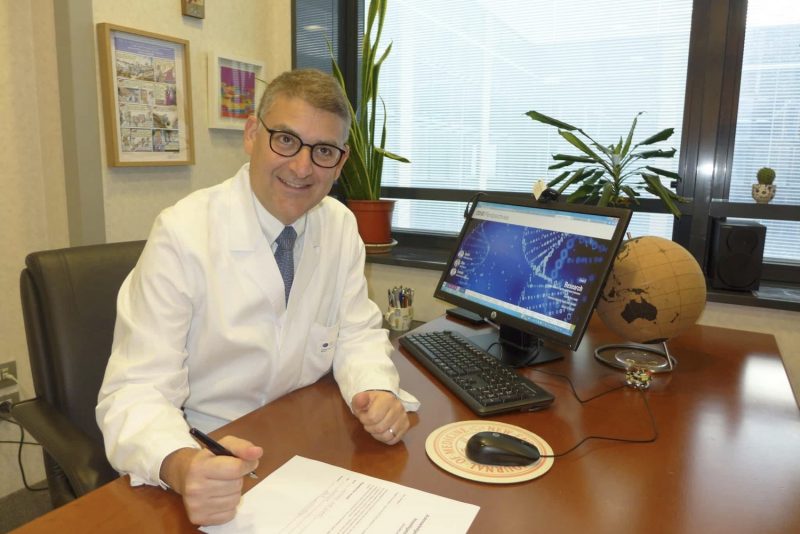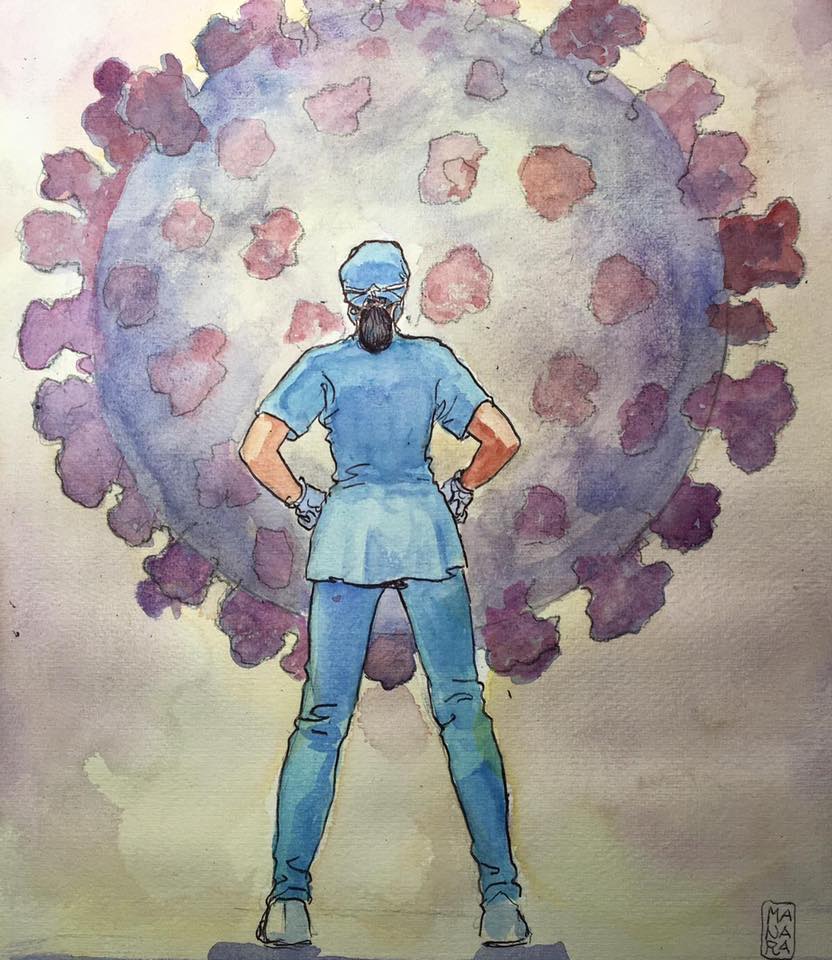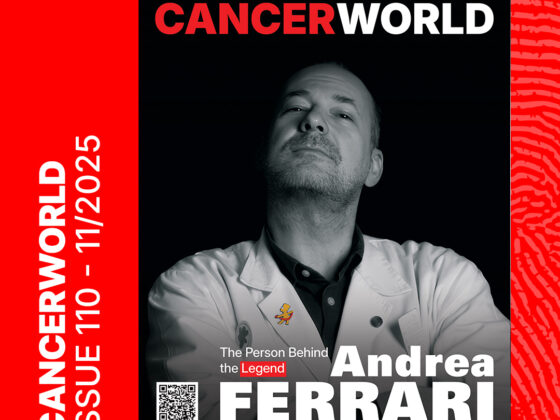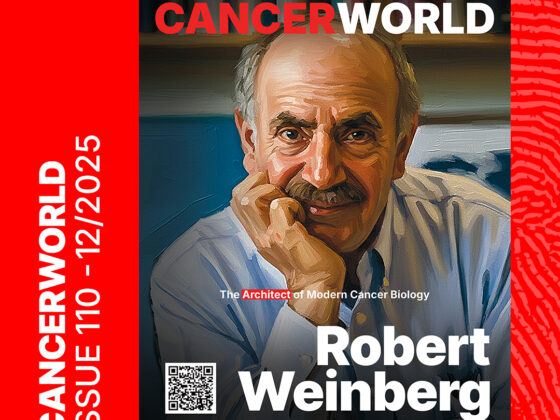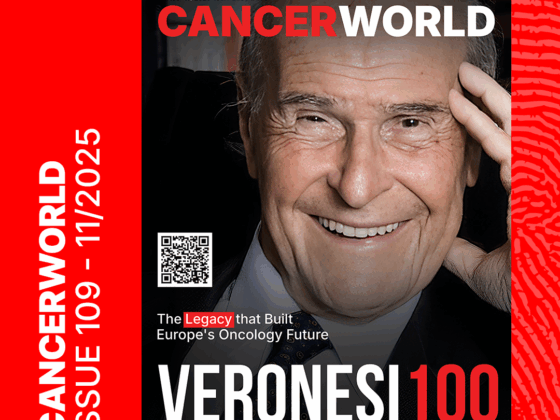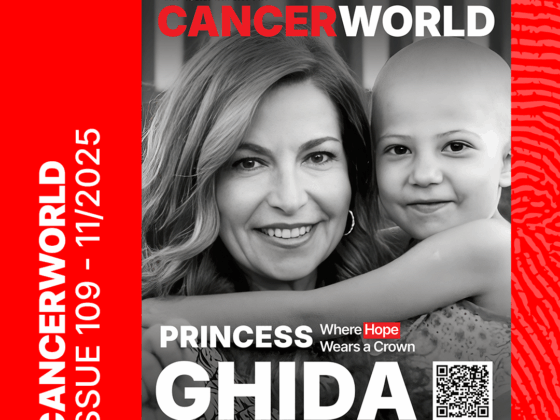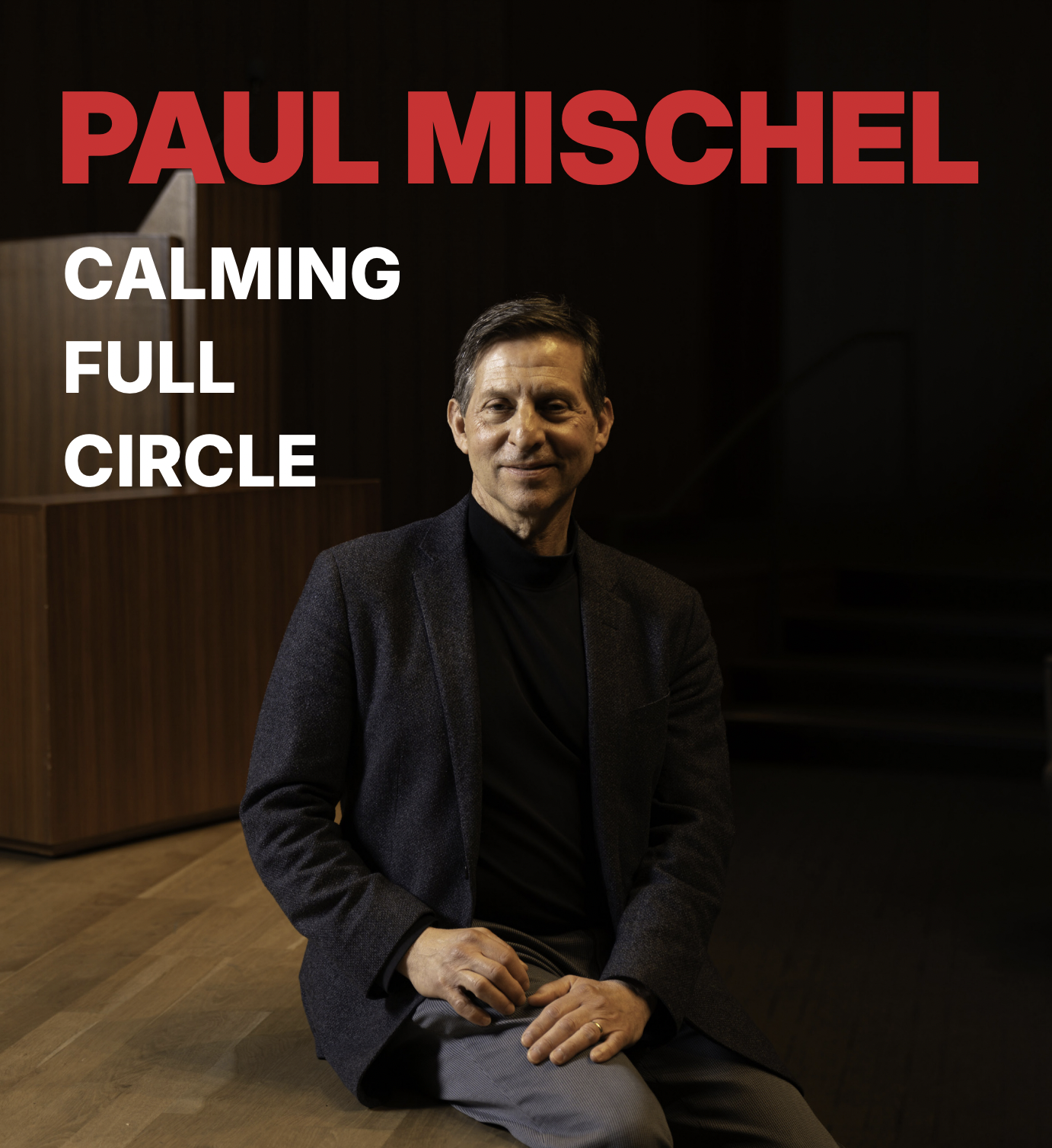“Fundamentally, if you do more whole genome sequencing, you’ll discover more targetable alterations, and once you have this information you can consider whether there are any clinical trials available for your patient.” The advice comes from Giuseppe Curigliano, Head of the Clinical Division of Early Drug Development at Milan’s European Institute of Oncology, and Professor of Medical Oncology at the University of Milan. He is painfully aware that few clinicians have the opportunities that he does to act on it, and that is something he is determined to change.
Curigliano is a goal-oriented dynamo galvanising the international community into taking action, with interests spanning the full gamut of oncology, including: basic science research; phase 1, 2 and 3 clinical trials; launching new cancer meetings; collaborating with other disciplines, for instance to mitigate the cardiotoxicity of cancer medications; and mentoring oncology trainees. As chair of the European Society for Medical Oncology (ESMO) Clinical Practice Guidelines Committee he has helped accelerate access to evidence-based drugs, and at the St Gallen International Expert Consensus conference he has helped identify unmet needs in early breast cancer. But at heart, Curigliano sees himself as a clinician. “Beyond clinical trials, scientific meetings, and next generation sequencing, what’s most important for me is to take good care of my patients,” he says.
Since April 2013 Curigliano has headed the Early Clinical Trials Division at the European Institute of Oncology – a position he regards as a tremendous privilege. “You know about the efficacy of new agents before they’re presented at medical meetings. Having such information at your fingertips means you can discuss treatment options with patients before approval. All your patients, not just those in clinical trials, get the opportunity of cutting-edge treatments,” he says.
Since he first started work at the division in 2001, Curigliano has witnessed tremendous progress in the success of the phase 1 trials. “In the beginning only about 20% made it through to clinical development. Now we are seeing an 80% success rate,” he says. The reason for improvement, he explains, has been the shift from cytotoxic drugs to targeted agents with a biological rationale underlying their probability of success.
Oncology phase 1 (first-in-human studies) differ from phase 1 studies in other medical conditions because safety profiles of anti-cancer agents do not allow for them to be tested in healthy volunteers. While the primary purpose of phase 1 cancer trials, which are not randomised, remains to determine recommended doses and define safety profiles, explains Curigliano, now phase 1 trials can also show evidence of clinical activity. “If we discover we have an excellent drug we’ll also look at duration of response and progression free survival,” he says.
“It’s not uncommon to observe ‘Lazarus-like’ effects”
Sometimes it is immediately obvious that targeted agents are working. “It is not uncommon to observe ‘Lazarus-like’ effects, where patients arrive in wheelchairs, start a targeted agent, then in as little as a week their life can be completely transformed,” he says.
At any one time the Early Clinical Trials Unit concurrently runs around 70 phase 1 trials of different drugs, and each year it treats around 250 patients from all over Italy. Nowadays most phase 1 protocols are ‘basket’ trials, where patient selection is based on identification of specific biomarkers, taking an agnostic approach to cancer treatment. For example, the recent phase 1 GARNET trial, which recruited patients from the Milan unit, used dostarlimab – a PD-1 blocking antibody – in patients with range of advanced solid tumours that were mismatch repair deficient and microsatellite instability–high, including colorectal, gastric, small intestinal, pancreatic, and ovarian cancers.
This trial model differs markedly from trials of cytotoxic agents, where organ of origin was always the starting point. “Since the drugs are biomarker driven, typically we need to screen 100 patients with multiple types of cancer using next generation sequencing to find one with the required mutation for the trial,” explains Curigliano. To recruit sufficient patients to reach statistical significance it has become necessary to run the trials across multiple phase 1 units around the world. The ARROW trial, for instance, which used pralsetinib to treat RET-altered solid tumours in 15 different tumour types, was conducted across 84 sites in 13 countries.
“Communication is an important part of the job, having weekly meetings with the other units to share data and understand exactly what’s going on,” he says.
To undertake this challenging work, Curigliano is proud to have built a crack team of 12 experts, including oncologists, research nurses, pharmacists, data analysts, study coordinators and regulatory affairs specialists, all highly skilled in precision medicine. “In phase 1 units, above all we need to guarantee the safety of the patients and the quality of data. You need to establish standard operating procedures to reduce risk of mistakes,” he says.
In patients with multiple mutations, to determine which biomarker to action first, Curigliano established a multidisciplinary tumour board. His initiative is firmly embedded in research; a European Journal of Cancer study published in 2023, showed that patients receiving treatment recommendations from molecular tumour boards (versus physician choice) achieve significantly longer overall and progression free survivals.
“Liquid biopsy provides opportunities to intercept progression prior to radiological evidence and switch to alternative treatments”
Curigliano is also working on analysis of liquid biopsies (blood samples containing DNA shed from tumours) to predict emergence of resistance to targeted therapies. The rationale for this move came from the report of the PADA-1 trial, published in the Lancet Oncology in 2023, which showed that women with ER-positive/ HER2-negative metastatic breast cancer on CDK4-6 inhibitors and letrozole, who switched to fulvestrant, when found to have ESR1 mutations, achieved longer progression free survival than those who remained on the standard of care. “PADA-1 shows how using regular liquid biopsy to monitor the tumour can impact patient outcomes. It provides opportunities to intercept progression prior to radiological evidence and hit patients with alternative treatments,” he says.
Getting there
Curigliano, now one of the most prominent names in Italian oncology, was born in Canada to parents who had emigrated from southern Italy to escape the severe economic depression after the Second World War. But when he reached his 10th year, the family made a decision to return back to a place the young Giuseppe had never known as ‘home’. “At the age of 10, moving back to a small village in Calabria after living in a suburb of Toronto, was a complete culture shock,” he remembers.
As a teenager Curigliano became fascinated by the region’s extraordinary linguistic diversity, which includes three historical ethnolinguistic languages with roots in Greek, Occitan and the Tosk dialect spoken in southern Albania. That interest inspired him to apply to university to study philology – the study of the organisation of speech sounds in languages. He soon switched to medicine, however, on the grounds that – fascinating though it is – philology does little to help humanity. Having made that switch, Curigliano was clear from early on that oncology was where he wanted to be. “At the time only two or three chemotherapy agents were available. There was a high unmet medical need, and I felt that oncology offered the best medical discipline to do research that might help people,” he says.
In January 1995, with limited medical oncology training available in Italy at that time, Curigliano moved to Columbia Comprehensive Cancer Center, in New York, where he got involved in research on detecting and quantifying DNA adducts, which can lead to cancerous mutations. His first paper, published in Carcinogenesis in 1996, explored relationships between cigarettes smoked and staining for DNA adducts in bladder cancer. “Scientifically it was a really exciting time – I was working on the development of monoclonal antibodies to recognise DNA adducts and using artificial intelligence to predict their formation,” he says.
It was therefore with some reluctance that Curigliano agreed to return to Italy in January 1999, after his wife, an emergency medicine doctor, decided she was uncomfortable practising within the litigious US system. With his international experience and ability to speak multiple languages, he secured a post at the European Institute of Oncology (IEO) in Milan. The institute had been founded by the leading oncologist Umberto Veronesi four years earlier, with the aim of developing a ‘comprehensive cancer centre’ that combined research laboratories and clinical services.
Here Curigliano benefited from IEO’s new disease-orientated oncology training programme, which gave him the opportunity to rotate through departments specialising in different solid tumours. For his Pharmacology PhD, awarded by the University of Pisa in 2006, he explored pharmacogenetic determinants of chemotherapy response in bladder and non-small-cell lung cancers.
This combined pharmacology/ oncology background made him a perfect fit for the newly established phase 1 trials unit at the Institute. “To my mind, conducting phase 1 trials offers the strongest link to translational research,” he says. “It allows you to bring molecules tested in preclinical models directly to patient care.”
Learning from the best
Two great influences on Curigliano’s early career were Umberto Veronesi (a pioneer in breast convserving surgery who died in 2016) and Aron Goldhirsch (a major figure in international collaborative breast oncology trials, who died in 2020). “Umberto had a remarkable talent for leadership. If he felt an idea was important, he had the power to persuade anyone to invest in it,” remembers Curigliano, who was inspired by Veronesi’s mantra ‘to give the minimum treatment necessary’ – whether surgery, radiotherapy, or chemotherapy – to achieve the best outcomes.
“Aron was very good at explaining that you do research to help patients and not to further your own career or publish papers”
In the 10 years he worked with Goldhirsch at IEO, Curigliano estimates they must have enjoyed more than 10,000 early morning cups of coffee together. “Aron was very good at explaining that you do research to help patients and not to further your own career or publish papers,” he says.
From Goldhirsch, he learnt three principles of oncology research: that study questions should be based on biological hypotheses; trials should complement each other, allowing information from separate studies to be combined to address shared clinical questions; and research questions should be selected for impact on patient care.
Goldhirsch, who was enormously influential in moving breast oncology from a ‘one-size fits all’ approach to the new paradigm of personalised treatment, undoubtedly inspired Curigliano to focus his clinical and research efforts on breast cancer – that and his recognition of the terrible impact it has on the lives of so many women.
At a scientific/clinical level, Curigliano views breast cancer as the trailblazer – the malignancy that above all other cancers has paved the way for the greater biological understanding of tumours. The discovery of human epidermal growth factor-2 (HER2) overexpression or amplification, he says, was one of the first steps towards precision oncology.
Curigliano views breast cancer as the trailblazer – the malignancy that has paved the way for the greater biological understanding of tumours
More recently, it was also the first solid tumour to show the potential of antibody drug conjugates in 2013, with the approval of trastuzumab emtamsine (T-DM1) for use in patients with metastatic HER2-positive breast cancer. Curigliano has very high hopes for this type of drug, which uses innovative linker technology to combine a monoclonal antibody (in this case trastuzumab which targets HER2 receptors) with a cytotoxic payload (in this case the chemotherapy agent emtamsine) thereby enabling potent drugs to be delivered selectively to cancer cells, simultaneously improving efficacy while limiting toxicity.
In 2022, the DESTINY-breast 04 trial showed that a HER2 targeted antibody-drug conjugate can be effective even in tumours where HER2 expression is below the levels where targeted drugs alone are able to elicit a response (so-called ‘HER2-low’), thereby significantly increasing the proportion of breast cancer patients who can benefit from drugs targeting HER2. The conjugate drug used in this trial was trastuzumab deruxetan (T-DXd), which uses trastuzumab to deliver a cytotoxic payload of the topoisomerase 1 inhibitor deruxetan.
Curigliano is currently chairing the DESTINY-breast 06 trial, which is exploring the impact of T-DXd used in an earlier line of treatment – following progression on endocrine therapy – in a population of patients with metastatic HER2-low breast cancer that includes some with ‘HER2-ultralow’ tumours (with a HER2 immunohistochemistry score above zero but less than 1). The results, which he recently presented at ASCO 2024 (the annual meeting of the American Society of Clinical Oncology), showed that, for those with HER2-low cancer, the median progression-free survival was 13.2 months for those who received T-DXd compared with 8.1 months for those who received chemotherapy. Importantly, similar results were seen in the small group of patients with HER2-ultralow cancer, which Curigliano points out could further increase the proportion of patients who can benefit from HER2 targeted therapies.
“Antibody-drug conjugates could ultimately offer a potential for cure for many patients with advanced breast cancer”
One possible mechanism proposed to explain the efficacy of T-DXd in cancers that present very low levels of the target is thought to be a ‘bystander effect’, whereby the chemotherapy portion of the conjugate drug is able to enter and kill tumour cells in the vicinity of HER2-positive cells, even if the cells in question have little or no HER2 – a mechanism that works for some, but not all, antibody-drug conjugates.
Curigliano believes this approach to treating breasts cancer could ultimately offer a potential for cure for many patients with oligometastatic disease (defined as having fewer than five metastatic sites) or de novo metastatic disease (first diagnosed after spreading to distant parts of the body). “Cure occurs if patients don’t relapse after you stop treatment, when they have achieved a complete response. We’re now starting to design clinical trials using this as an endpoint,” he says.
Spreading knowledge and access
Given how fast things are changing in this field, Curigliano stresses the urgent need for guidelines to provide a bridge between scientific investigators and oncology practitioners, that can help to rapidly disseminate new findings. Between 2019 and 2023, Curigliano chaired the Guidelines Committee of the European Society for Medical Oncology (ESMO), working on a range of guidelines, including ESMO’s first on treating metastatic breast cancer. “We defined breast cancer according to genomic alterations, thereby identifying a treatment pathway based on precision medicine,” he says.
That work was brutally interrupted, however, by the Covid pandemic, which hit northern Italy early and hard. It derailed his ambitions for the guidelines work, and massively curtailed his clinical trials work. “This was the most negative period of my life, full of wasted opportunities,” he recalls. “It stopped me realising my dream of delivering clinical practice guidelines, and delayed the results of important clinical trials.” He is also painfully aware of what this meant in terms of patient care. “In Italy around 5 to 7% of cancer patients, literally thousands of people, missed the opportunity to enrol in clinical trials and receive drugs that could have transformed their condition.”
Curigliano turned his skills and experience in collaborative approaches to generating and analysing evidence to the task of rapidly learning about the risks that the virus presented to cancer patients, and how best to mitigate them (see box).
A leading voice during Covid
The first encounter the Western world had of the Covid-19 pandemic came in the form of terrifying pictures of queues of ambulances outside hospitals in northern Italy and medics in HazMat suits, alongside reports of overflowing morgues. Based in Milan, Giuseppe Curigliano and his colleagues were among the first in the western cancer community to be faced with decisions on how to respond. He quickly became an important voice at an international level, talking from the Italian experience about balancing the risks of Covid exposure against the risks of delaying treatment, and he played a leading role in efforts to promote international data gathering and sharing, to generate robust evidence that could inform practice.
In an interview in The Cancer Letter, 13 March 2020, Curigliano delivered a stark warning to the US government to apply ‘Procedures of social isolation and of containment’ as soon as possible. “It’s like being in a war,” he said at that time, “My advice is to be very careful, because this is not the flu.”
Overcaution could, however, be equally fatal to cancer patients. Curigliano spearheaded early efforts to pull together consensus-based guidance to help healthcare professionals overcome clinical and technical obstacles related to diagnosis, risk assessment, response assessment, surgical planning, radiotherapy, and medical treatment. “I tried to let people throughout the world understand that we should be taking care of cancer patients during the epidemic, and that it was essential to deliver the best care independent of Covid,” he says. The ESMO expert consensus, was published online at the end of July 2020, with a final version published in print in October that year.
A major innovation introduced during his leadership of the ESMO Guidelines Committee was the development of ‘ESMO Living guidelines’. “Every week new data becomes available, making it important to develop a treatment algorithm that presents changes in a rapid way without having to rewrite guidelines all over again,” he explains. Data is presented in an intuitive and graphic way, allowing generalists, not just experts, to understand best care for their patients.
He is all too aware, however, that the practice of precision cancer medicine depends not just on doctors having the right knowledge and guidelines, but also on patients having access to the precision diagnostics. He is a passionate advocate for widening access to next generation sequencing, and has used his position as the only oncologist to sit on the Ministry of Health’s National Advisory Council to progress this agenda within the Italian healthcare system.
“This decision does not mean universal access to NGS, but it is a first step towards the democratisation of precision medicine”
In February 2023, the Italian Ministry of Health launched a fund for the statutory reimbursement of next generation sequencing testing for biomarkers based on the ESMO Scale for the Clinical Actionability of molecular Targets, ESCAT. The Scale stratifies levels of clinical evidence for molecular targets into six tiers, according to the implications for patient management. The Italian reimbursement scheme allows all tests for tier I and tier II molecular alterations to be covered. “This decision does not mean universal access to NGS [next generations sequencing], but it is certainly an extension of financial coverage for all those tests which give patients access to drugs that impact their outcomes, representing a first step towards the democratisation of precision medicine,” says Curigliano.
His advocacy efforts extend much further than his home country, however – and indeed further than just oncology. In February 2018, Curigliano organised the first summit on precision medicine, held in Milan, which brought together experts from academia, industry, and regulatory bodies to discuss how to overcome barriers to rolling out precision medicine in routine clinical practice.
Curigliano is perfectly aware of the numerous challenges that large-scale use of genomic testing poses to health services, with regard to affordability, data security, education of doctors and genetic counsellors, criteria to decide which techniques to reimburse for which patients, policies on handling unsolicited germline findings that may have immediate impact on patient’s relatives, and more.
Ensuring progress in precision medicine is widely available – democratising oncology – is a recurring and important theme of his. In May 2019, together with Sibylle Loibl (Goethe University of Frankfurt), Curigliano established the first ESMO Breast meeting, held that year in Berlin. “The meeting provides the European breast cancer community with access to world class research. It offers great opportunities for European delegates who can’t travel to San Antonio to present data and network,” he says.
He views the future of oncology with great optimism. Part of this comes from the residents he teaches in his role as Professor of Oncology at the University of Milan. “It’s great to mentor so many brilliant young people, with their enthusiasm, commitment, and dreams for the future. You can inspire and support them, knowing they’ll eventually go way beyond you,” he says.
Then there are the innovations. With antibody-drug conjugates he predicts we will soon be able to computer design agents to allow personalisation of both antibodies and payloads. In this brave new world of oncology, Curigliano envisages that each patient will have their own computer ‘avatar’ that integrates their biomic, genomic and multiomic data into in silico computer models. “This would allow identification of the most appropriate treatment and give advanced warning of the likelihood of patients developing resistance,” he says. “The model could incorporate all possible patient trajectories and calculate every single risk. It would be more than precision medicine, since it would allow you to personalise treatment for every single patient.”
As with any advance, access to this precision medicine wizardry will inevitably be restricted, at least at the start. It seems, therefore, that Curigliano will need to continue campaigning for the democratisation of cancer treatments for some time to come.

